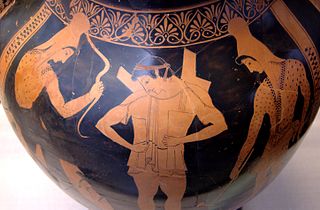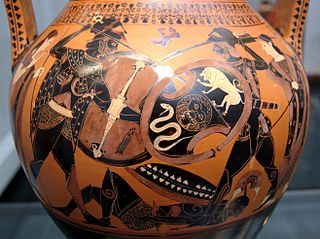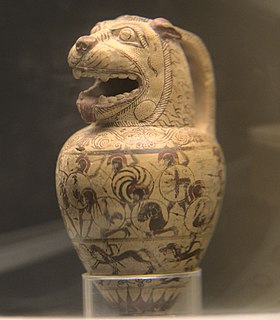
In the pottery of ancient Greece, a kylix is the most common type of wine-drinking cup. It has a broad, relatively shallow, body raised on a stem from a foot and usually two horizontal handles disposed symmetrically. The main alternative wine-cup shape was the kantharos, with a narrower and deeper cup and high vertical handles.

Ancient Greek pottery, due to its relative durability, comprises a large part of the archaeological record of ancient Greece, and since there is so much of it, it has exerted a disproportionately large influence on our understanding of Greek society. The shards of pots discarded or buried in the 1st millennium BC are still the best guide available to understand the customary life and mind of the ancient Greeks. There were several vessels produced locally for everyday and kitchen use, yet finer pottery from regions such as Attica was imported by other civilizations throughout the Mediterranean, such as the Etruscans in Italy. There were a multitude of specific regional varieties, such as the South Italian ancient Greek pottery.

Black-figure pottery painting, also known as the black-figure style or black-figure ceramic, is one of the styles of painting on antique Greek vases. It was especially common between the 7th and 5th centuries BC, although there are specimens dating as late as the 2nd century BC. Stylistically it can be distinguished from the preceding orientalizing period and the subsequent red-figure pottery style.

Red-figure vase painting is one of the most important styles of figural Greek vase painting.

The Kleophrades Painter is the name given to the anonymous red-figure Athenian vase painter, who was active from approximately 510–470 BC and whose work, considered amongst the finest of the red-figure style, is identified by its stylistic traits.

Euphronios was an ancient Greek vase painter and potter, active in Athens in the late 6th and early 5th centuries BC. As part of the so-called "Pioneer Group,", Euphronios was one of the most important artists of the red-figure technique. His works place him at the transition from Late Archaic to Early Classical art, and he is one of the first known artists in history to have signed his work.

Euthymides was an ancient Athenian potter and painter of vases, primarily active between 515 and 500 BC. He was a member of the Greek art movement later to be known as the Pioneer Group for their exploration of the new decorative style known as red-figure pottery. Euthymides was the teacher of another Athenian red-figure vase painter, the Kleophrades Painter.

The Brygos Painter was an ancient Greek Attic red-figure vase painter of the Late Archaic period. Together with Onesimos, Douris and Makron, he is among the most important cup painters of his time. He was active in the first third of the 5th century BCE, especially in the 480s and 470s BCE. He was a prolific artist to whom over two hundred vases have been attributed, but he is perhaps best known for the Brygos Cup, a red-figure kylix in the Louvre which depicts the "iliupersis" or sack of Troy.
Darrell Arlynn Amyx was an American classical archaeologist. His principal field of study was the archaic pottery of Corinth. Complementing the pioneering work of John Beazley and Humfry Payne, Amyx applied stylistic analysis to the work of previously unnamed and unstudied Corinthian painters, discerning many otherwise forgotten "hands".

In classical archaeology, a name vase is a specific "vase" whose painter's name is unknown but whose workshop style has been identified. The painter is conventionally named after the selected "name vase" that embodies his characteristic style, or for one of its distinctive painted subjects, or for other attributes.

The Analatos Painter was an Attic vase painter of the Early Proto-Attic style.

The Oreithyia Painter was an ancient Greek red-figure vase painter who flourished from 470–460 BCE. He is one of the many painters of the red-figure Classical Period, but his work is not considered the finest or well-known. This is partly because he began painting during the transition from red-figure to black-figure pottery.
The Painter of Palermo 489 was an ancient Corinthian vase painter in the black-figure style; his real name is unknown. He was active during the transitional period between orientalising vase painting and black-figure proper. He is known especially as the teacher of the Columbus Painter and thus a major indirect influence on several further Early Corinthian artists, such as the Chimaira Painter and the Chimaira Group. Darrell A. Amyx describes him as "the Columbus Painter's great teacher" and a "powerful and accomplished painter". He painted mostly aryballoi.

Dodwell Painter was an ancient Corinthian vase painter in the black-figure style whose real name is rather unknown. He was active during the Middle and Late Corinthian periods and his works dates back to 580 to 570 BC.

The Amykos Painter was the name given to a South Italian vase painter who worked in the ancient Greek red-figure pottery technique. His exact date of birth and death are unknown.

Ancient Greek art stands out among that of other ancient cultures for its development of naturalistic but idealized depictions of the human body, in which largely nude male figures were generally the focus of innovation. The rate of stylistic development between about 750 and 300 BC was remarkable by ancient standards, and in surviving works is best seen in sculpture. There were important innovations in painting, which have to be essentially reconstructed due to the lack of original survivals of quality, other than the distinct field of painted pottery.
The conservation and restoration of ancient Greek pottery is a sub-section of the broader topic of conservation and restoration of ceramic objects. Ancient Greek pottery is one of the most commonly found types of artifacts from the ancient Greek world. The information learned from vase paintings forms the foundation of modern knowledge of ancient Greek art and culture. Most ancient Greek pottery is terracotta, a type of earthenware ceramic, dating from the 11th century BCE through the 1st century CE. The objects are usually excavated from archaeological sites in broken pieces, or shards, and then reassembled. Some have been discovered intact in tombs. Professional conservator-restorers, often in collaboration with curators and conservation scientists, undertake the conservation-restoration of ancient Greek pottery.
The hoplites were soldiers from Ancient Greece who were usually free citizens. They had a very uniform and distinct appearance; specifically they were armed with a spear (dory) in their right hand and a heavy round shield in their left.

The Macmillan aryballos is a Protocorinthian pottery aryballos in the collection of the British Museum. Dating to about 640 BC, it is 6.9 cm high and 3.9 cm in diameter, and weighs 65 grams.















